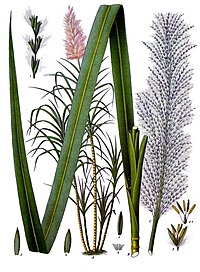
Photo from wikipedia
The stem and leaves of fresh corn plants can be used as green silage or can be converted to biofuels, and the stalk sugar content and yield directly determine the… Click to show full abstract
The stem and leaves of fresh corn plants can be used as green silage or can be converted to biofuels, and the stalk sugar content and yield directly determine the application value of fresh corn. To identify the genetic variations and candidate genes responsible for the related traits in fresh corn, the genome-wide scan and genome-wide association analysis (GWAS) were performed. A total of 32 selective regions containing 172 genes were detected between sweet and waxy corns. Using the stalk sugar content and seven other agronomic traits measured in four seasons over two years, the GWAS identified ninety-two significant single nucleotide polymorphisms (SNPs). Most importantly, seven SNPs associated with the stalk sugar content were detected across multiple environments, which could explain 13.68–17.82% of the phenotypic variation. Accessions differing in genotype for certain significant SNPs showed significant variation in the stalk sugar content and other agronomic traits, and the expression levels of six important candidate genes were significantly different between two materials with different stalk sugar content. The genetic variations and candidate genes provide valuable resources for future studies of the molecular mechanism of the stalk sugar content and establish the foundation for molecular marker-assisted breeding of fresh corn.
Journal Title: International Journal of Molecular Sciences
Year Published: 2022
Link to full text (if available)
Share on Social Media: Sign Up to like & get
recommendations!